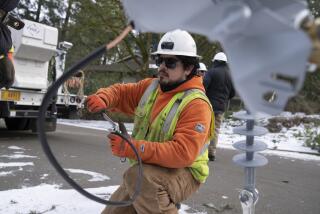Time to declare a manufacturing renaissance?
- Share via
Is it time to finally declare a manufacturing renaissance? An index by the Institute for Supply Management has grown for 33 straight months, and Rust Belt states such as Ohio and Michigan have registered big drops in unemployment over the year. Ohio dropped to 7.5% unemployment in March from 8.8% the previous year, and Michigan dropped to 8.5% from 10.5% in March of last year.
The folks at Manning & Napier, the $40-billion asset management firm, say there are some reasons to be very optimistic about manufacturing in the U.S. Wages overseas are rising – China alone has experienced double-digit wage growth in each of the last two years. Supply chain disruptions in the wake of the Japanese tsunami are making companies rethink depending solely on emerging markets for products. And the U.S. energy boom makes it cheaper to pay the utility bills if you manufacture here.
“We are in the very early innings of this trend,” said Chris Petrosino, managing director of the quantitative strategies group at Manning & Napier.
This is the first time in more than two decades that manufacturing employment as a percentage of total nonfarm employment has stopped falling, according to a Manning & Napier report entitled “The U.S. Manufacturing Renaissance: Silver Lining, Not Silver Bullet.” The nation has added nearly half a million manufacturing jobs from January 2010 to February 2012. While employment won’t return to 1970s levels, the multiplier effect that manufacturing has on the economy is good news – every factory job added creates three additional jobs.
The areas benefiting from this trend are specific, said Michael Knolla, a research analyst at the firm. They’re areas with access to low-cost transportation, rail centers and low-cost energy.
“It used to be you wanted access to a hydroelectric dam, now you want access to the pipelines,” he said.
And it’s not every type of product being manufactured in the U.S as a part of this trend. Those that are heavy to ship but cheaper to sell are more likely to be made here. For example, a washing machine is a good candidate to be made in the U.S.A. since it is heavy to ship and not that expensive to sell. A car, on the other hand, may be heavy to ship, but is still pricey on the market, so worth making overseas. Products that are customized are more likely to be made here, as well as those that companies need quickly.
The one obstacle to this renaissance: skills. As manufacturing is automated, companies need more skilled workers to run machines, Knolla said. During the recession, training programs have been scrapped and it’s nearly impossible for low-skilled workers to move up the chain. Until that problem is solved, the renaissance has a real chance of going kaput.
More to Read
Inside the business of entertainment
The Wide Shot brings you news, analysis and insights on everything from streaming wars to production — and what it all means for the future.
You may occasionally receive promotional content from the Los Angeles Times.











